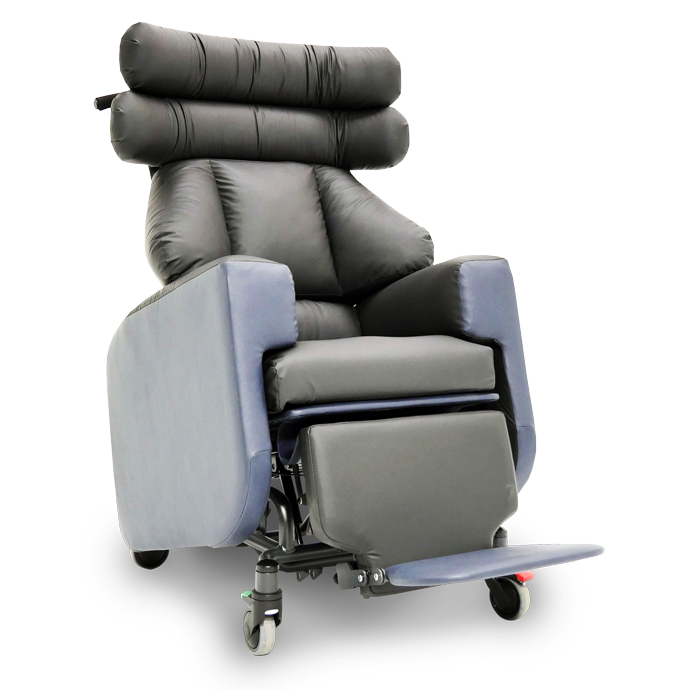Last Updated on 25/10/2023 by Sarah Sarsby
Tri-Chair, a specialist posture and pressure care management seating firm that recently became a member of the British Healthcare Trades Association (BHTA), has helped Rob Burrow MBE get a modular chair that meets his changing needs.
Rob was born in West Yorkshire in 1982. Having made his rugby league debut for Leeds Rhinos in 2001, Rob went on to become a legend of the game, making 493 appearances for his club, winning eight Super League titles, two Challenge Cups, three World Club trophies, and three League Leader’s Shields.
Rob also made 22 appearances representing England, Great Britain, and Yorkshire, and was inducted into the Leeds Rhinos hall of fame in 2020.
In 2019, Rob was diagnosed with motor neurone disease (MND), which is a degenerative neurological condition affecting the neurones in the brain and spinal cord, impacting on movement, body control, speech, and all muscular control.
Rob initially noticed some problems with his speech that led to investigations, including an MRI and nerve conduction studies, the results of which were confirmed by a neurologist.
Over the last four years, Rob’s condition has progressed, and he is now reliant on support for all activities of daily living (ADLs).
Despite Rob’s initial reluctance to seek help, he had a visit from an occupational therapist who made recommendations for seating specifically. Rob uses a profiling bed, which he says has been a “real lifesaver”. It enables him to change his position regularly and remain comfortable.
After some time, Rob posted a Tweet (now X) stating he felt it was “time to consider a specialist chair”. This is when a mutual friend introduced Rob to Shaun McCluskey, who works with Channel Healthcare and Tri-Chair.
Shaun took time to get to know Rob and his family. For Shaun and Rob, it was crucial that the equipment recommendation process was clear, transparent, and focused on what Rob and his family wanted to achieve, while providing information that empowered them to make an informed, capacitated decision.
Rob was able to clearly identify his goals for seating. He said: “To be able to sit comfortably for prolonged periods of time and to ensure that I don’t develop pressure areas/sores. I have drinks and eat my meals in the chair, so I need to have adequate head and trunk support for feeding.
“It is essential that I have good sitting posture for everyday tasks such as eating and drinking. I use a communication device, so I need to have good posture to be able to use my machine to communicate using my eye movement.”
Rob also made it clear that he and his wife wanted to avoid turning the house into a healthcare setting. Equipment needed to be aesthetically pleasing as well as unintrusive.
Rob becomes tired quickly, and this impacts on both posture and his ability to engage in activities that are meaningful to him, particularly with his family.
The chair that Rob was sitting on initially did not provide any pressure relief and was actively generating heat and encouraging sheer. Due to Rob’s reduced core strength and balance, he was leaning to his left side, with pressure mapping conducted to provide key evidence that would support Shaun’s recommendations and Rob’s decisions.
The pressure mapping identified some key areas of risk, including the left buttock, ischial tuberosity, and right thigh due to windswept posture.
Rob’s sitting posture, particularly relating to trunk and head support, was compromising a safe swallow and therefore increasing chances of aspiration.
Each of the above challenges impacted on Rob’s ability to engage in meaningful activities and ADLs. His roles were being even more greatly affected, and this was impacting on carers around him.

Through a combination of time spent with Rob and his family, listening carefully to his views and goals, and providing evidence to support the rationale, Shaun recommended the Tri- Chair Three. This is a tilt-in-space, adjustable seating system, which, as it’s modular, can be adapted to meet Rob’s changing needs.
The Tri-Chair team also recommended a moulded seat and backrest, which provide more support when Rob gets particularly tired. As well as supporting Rob’s goals, this option allows Rob, his wife, and care team to interchange cushions, depending on the social situation and environment, in order to reduce the healthcare look and feel of the chair whenever that is appropriate for them.
Rob had a trial of the Tri-Chair Three, supported by Shaun and the team, so that it could be altered to meet Rob’s specific needs. This included a pommel to prevent further adduction and the moulded seat so that pressure was redistributed more evenly without Rob having to be in a tilted position so regularly.
This in turn meant that Rob could be more engaged and communicate with good eye contact, promoting dignity and respect.
The outcome was the product of a collaborative process, built on trust.
Rob concluded: “The design of the chair means that it can be adapted to meet my needs. For example, I felt that the trunk support was too restrictive on one of my chairs, so the pads were removed without compromising my overall comfort or posture in the chair. Extra padding/support can be added, and the chairs can be tilted with feet up/down, which helps alleviate pressure.
“The Tri-Chair has improved my quality of life.
“I don’t think I would cope without the chair, which was tailor made for me. I certainly miss my Tri-Chair when I get away somewhere. I have to look forward to the time I have my home comforts.”